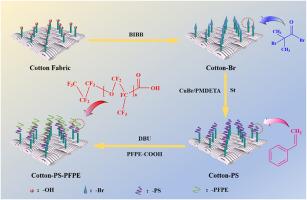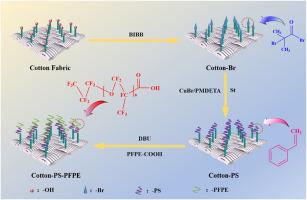Polystyrene graft modification of cotton fibers by ATRP in situ surface roughening and superhydrophobic fabrics
IF 4.5
2区 化学
Q2 POLYMER SCIENCE
引用次数: 0
Abstract
In this paper, 2-bromoisobutyryl bromide (BIBB) was used to gain access to the active site of an atom transfer radical polymerization (ATRP) reaction on fiber surface to prepare a Cotton-Br macromolecular initiator. It was then used to trigger the ATRP polymerization of styrene under the PMDETA/CuBr system. The influence of monomer concentration, bath ratio, and grafting time on the in situ generation of micro- and nanomorphic coatings on fiber surfaces were also investigated. Cotton-PS, a cotton fabric with controllable rough morphology of fiber surface, was obtained through the adjustment of grafting reaction conditions. Energy dispersive spectroscopy (EDS), X-ray photoelectron spectroscopy (XPS), scanning electron microscope (SEM), Fourier transform infrared spectroscopy (FT-IR) and atomic force microscope (AFM) test proved that grafting reaction was successful. The C–Br on coating surface can condensed with perfluoropolyether carboxylic acid (PFPE-COOH), and the ensuing reaction introduces Diazabicycloundecene (DBU), thereby activating the PFPE-COOH. Under mild reaction conditions, this process produces superhydrophobic cotton fabrics. The effect of different molecular weight PFPE-COOHs on hydrophobicity was also investigated during chemical modification. The contact angle (CA) of modified cotton fabric increased from 144.8 ± 3.6° to 155.2 ± 3.5° after chemical modification with PFPE-COOH, exhibiting superhydrophobicity. The finished fabric showed excellent oil-water separation performance. Subsequent to the completion of 10 cycle tests, its oil-water separation efficiency was maintained at 98.6 %.


聚苯乙烯接枝改性棉纤维的ATRP原位表面粗化及超疏水织物
本文利用2-溴异丁基溴(BIBB)进入纤维表面原子转移自由基聚合(ATRP)反应的活性位点,制备了棉-溴大分子引发剂。然后用它在PMDETA/CuBr体系下触发苯乙烯的ATRP聚合。研究了单体浓度、浴液比和接枝时间对纤维表面微纳米涂层原位生成的影响。通过对接枝反应条件的调整,获得了纤维表面粗糙形貌可控的棉织物cotton - ps。能量色散谱(EDS)、x射线光电子能谱(XPS)、扫描电镜(SEM)、傅里叶变换红外光谱(FT-IR)和原子力显微镜(AFM)测试证明接枝反应成功。涂层表面的C-Br可以与全氟聚醚羧酸(PFPE-COOH)缩合,随后的反应引入重氮杂环癸烯(DBU),从而激活PFPE-COOH。在温和的反应条件下,该工艺可生产超疏水性棉织物。在化学改性过程中,考察了不同分子量的pfpe - cooh对其疏水性的影响。经PFPE-COOH化学改性后,棉织物的接触角(CA)由144.8±3.6°增加到155.2±3.5°,表现出超疏水性。织物具有良好的油水分离性能。经过10次循环试验,其油水分离效率保持在98.6%。
本文章由计算机程序翻译,如有差异,请以英文原文为准。
求助全文
约1分钟内获得全文
求助全文
来源期刊

Polymer
化学-高分子科学
CiteScore
7.90
自引率
8.70%
发文量
959
审稿时长
32 days
期刊介绍:
Polymer is an interdisciplinary journal dedicated to publishing innovative and significant advances in Polymer Physics, Chemistry and Technology. We welcome submissions on polymer hybrids, nanocomposites, characterisation and self-assembly. Polymer also publishes work on the technological application of polymers in energy and optoelectronics.
The main scope is covered but not limited to the following core areas:
Polymer Materials
Nanocomposites and hybrid nanomaterials
Polymer blends, films, fibres, networks and porous materials
Physical Characterization
Characterisation, modelling and simulation* of molecular and materials properties in bulk, solution, and thin films
Polymer Engineering
Advanced multiscale processing methods
Polymer Synthesis, Modification and Self-assembly
Including designer polymer architectures, mechanisms and kinetics, and supramolecular polymerization
Technological Applications
Polymers for energy generation and storage
Polymer membranes for separation technology
Polymers for opto- and microelectronics.
 求助内容:
求助内容: 应助结果提醒方式:
应助结果提醒方式:


